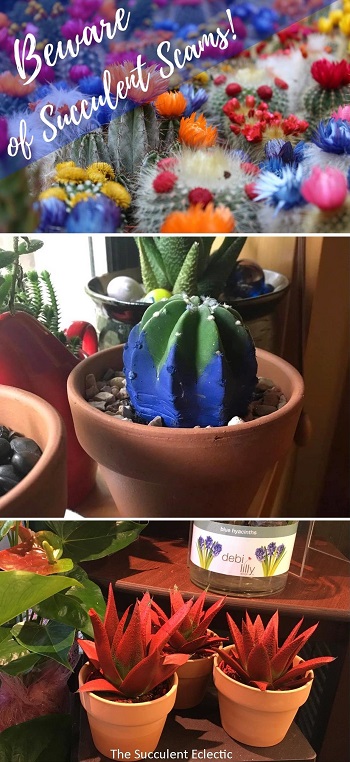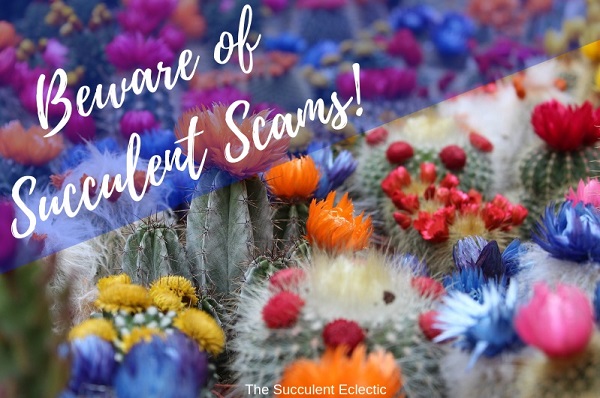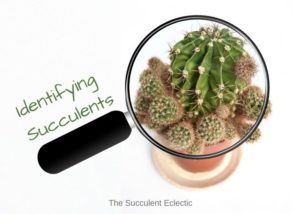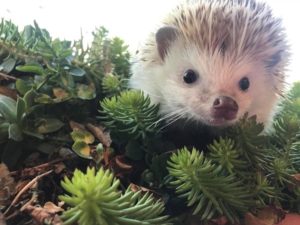When you first fall in love with succulents, any ole plant will do. But soon, you hunger for more — more color, more diversity, something unusual. You’ll see spectacular images of amazing plants online and send away for cuttings, plants or seeds. Maybe you spot something special at the grocery
Succulent Scams Come in Many Forms
In this Post We'll Cover:
{Please note, some links in this post may be affiliate links to sites that pay me a small commission if you click on the link and make a purchase. This commission is at absolutely no cost to you. I only recommend products and companies that I have worked with and truly love! ~Kat}
Painted Succulents, Strawflower Cactus and Fake Seeds
But what qualifies as a succulent scam? There’s sort of a sliding scale of scam or fraud here. If you like the look of dyed or painted succulents — and you understand that’s what you’re buying — good then. I won’t judge you. And if you like the strawflower cactus and you know what it is when you buy it, then that’s great. Enjoy. But I do want you to be informed. Of course, there is no upside whatsoever with fraudulent seeds sold for succulents that do not exist. So this post is not going to debate the relative merits of these artificially “enhanced” products. I want to inform you so you won’t feel tricked or get cheated.
What is a Strawflower Cactus?
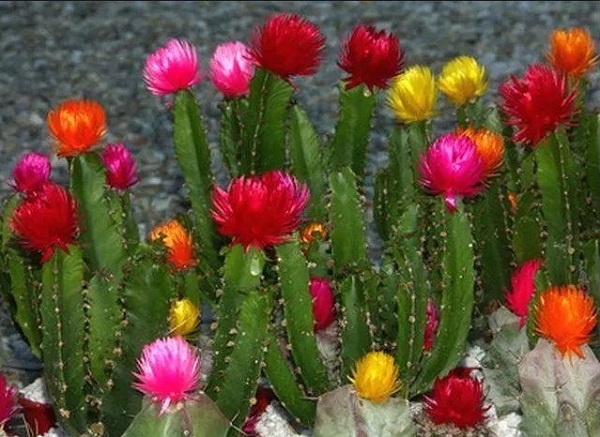
Any variety of cactus with a dried strawflower attached to it, is called a strawflower cactus. The flower is attached by a pin or hot glue, to make the plant look like it’s blooming. This is done to make the plant more appealing to buyers. What makes these fake flowers so intriguing is that they are true flowers from the Xerochrysum
Care for a strawflower cactus the same way as for the cactus without a flower glued to it. Plant it in fast-draining succulent soil and water only when the soil is dry. Provide bright light. Removing the flower is a challenge. If it is pinned on, remove the pin. The holes will scar over and heal. Although hot glue can be applied to some succulents without damaging them, it tends to cause problems with cactus. Usually, the glue attaches to the cactus spines, making it impossible to remove without tearing the spines and some of the flesh from the cactus. This results in unsightly scars on the plant, that should heal and become less noticeable, in time.
Strawflower cactus do not, of course, exist in nature. Hot gluing dried, dyed flowers on them is a gimmick used to sell more plants. You’ll find these at big box stores like Lowe’s, Home Depot and Walmart as well as grocery stores. The cactus are usually quite healthy, and doctored by the grower, rather than the seller. If you
Recognizing Genuine vs Fake Cactus Flowers
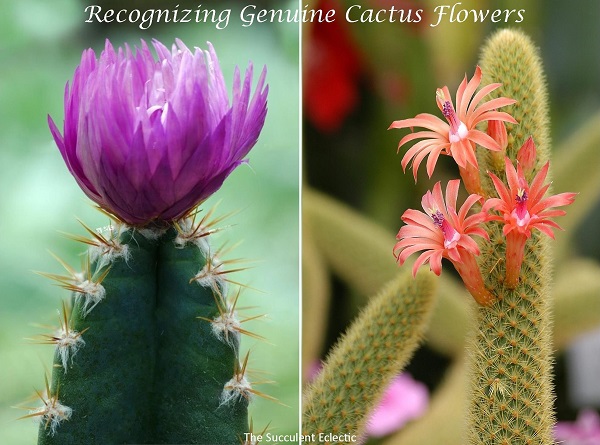
The above image shows a strawflower cactus with a dried bloom glued on top on the left, and a genuine, blooming cactus on the right.
- Cactus flowers are silky and cool to the touch
- Cactus blooms always form on short stems
- They usually sprout from the side of the plant
- Cactus flowers last several days before fading
Xerochrysum
Again, if you like the strawflower cactus — I have no intention of discouraging you. But the internet is full of posts from people excited to have a cactus blooming for 6 months, only to feel foolish and cheated when they realize they were tricked. You have a right to know what you are buying. And please — if you see someone excited about their own cactus, not realizing the blooms are fake, please break the truth gently.
Dyed Succulents
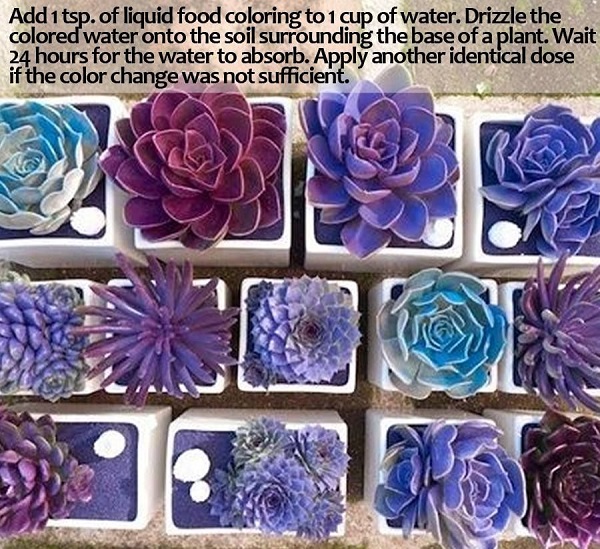
You’ve probably seen this image on Pinterest, showing how to dye your growing succulents to bring out more vivid coloring. This does not work. This image was faked, either by using Photoshop or by taking succulent cuttings and setting the cut stems into food coloring. This trick will work on succulent cuttings for the same reason it works on cut flowers, like carnations. Rooted succulents, however, will not turn colors when watered with food coloring. The roots are particular about what nutrients they take up. Recognizing the dye is of no value to the plant, the roots do not transmit the dye to the rest of the succulent.
Painted Succulents and Cactus
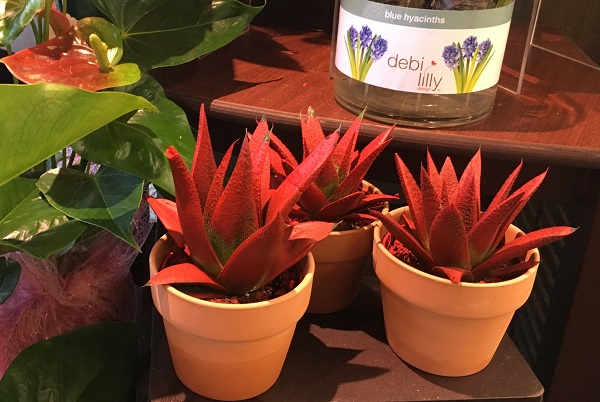
We all love colorful succulents. That’s why some growers will stress succulents to bring out their natural coloring, while others resort to gimmicks like gluing fake flowers on cactus or spray painting succulents. The goal is to sell more plants. And it works. I took this picture at my local Vons grocery store, where they have a large floral department. In this case, the paint job is very obvious. Sometimes, it is so thorough, it can be hard to spot. The company that markets these painted succulents — Kosmic Kactus — states that this paint is non-toxic, long-lasting and waterproof. Certainly, it is impossible to remove all of the paint without damaging the plant. They consider the look an “attractive bi-color effect” that is revealed as the plant’s natural color becomes apparent as it grows.
Most of these painted succulents and cactus are labeled with the information that they have been painted. Those moved to new pots without the label are likely the result of innocent changes made by staff at the store. Nevertheless, if you are aware of this practice, you will not be fooled. That being said, if you like this look — go for it. But I am troubled to see posts on social media from people who were deceived and feel humiliated once they realize their error. Can you imagine giving such a plant to your boss for the holidays, only to find out later that it was painted?
Can Kosmic Kactus Plant Be Saved?
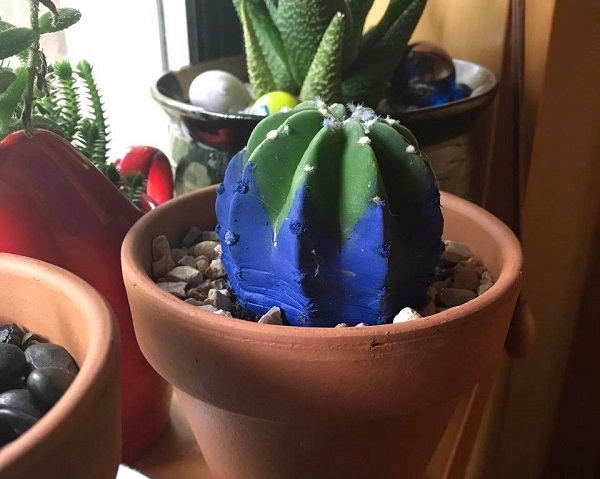
Some succulent lovers are so upset to see these painted succulents, they buy them to try to save them. You’ll find many videos of people trying — and failing — to remove the paint from their plants. Usually, there is no way to remove most of the paint. But the Kosmic Kactus claims appear to be true — somehow, the plants continue to photosynthesize through the paint. They also do not become etiolatedA plant is etiolated (EE-tee-oh-late-ed) when it grows very .... How this can be true, I really do not know.
Here, you see a photo of a cactus Megan Bogle Kirk bought to try to save. She was unable to remove the paint, so she wanted to see if the plant would live. It did survive and is slowly outgrowing its blue paint job. Here, it shows 4 months of healthy growth. Connect with Megan on Instagram, and you’ll see her succulent collection with #eurekasucculents.
In this world of fierce divisions, you cannot tap into more rage and invective than by posting an image of painted succulents. People will hotly declare than anyone painting succulents should be shot. Or they’ll argue that even Hitler didn’t paint plants. Or they’ll say no real gardener could like this. I understand the sentiments, but I would urge more civil discourse. I don’t want to demonize others — especially not if they love succulents! 🙂
Beware Fake Seed Sellers
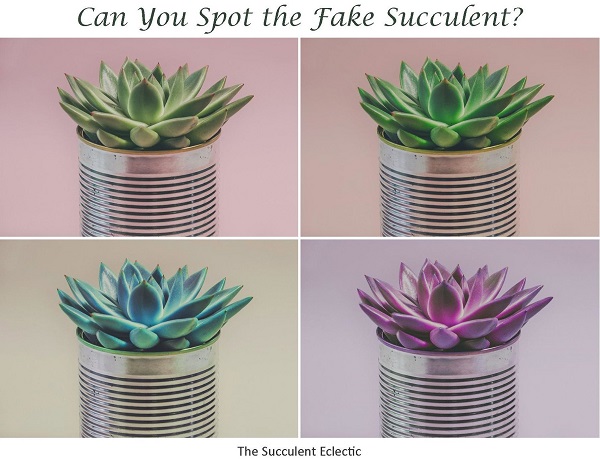
Now we come to the very bottom of the sliding scale of succulent scams — outright fraud. You’ll find vendors on eBay, Amazon and Etsy and elsewhere who are happy to sell you “seeds” for nonexistent succulents. Sometimes the seeds received are not even seeds. They may be sand or paprika or a similar substance. Other times, you may receive sesame seeds or bird seed instead of the super duper rare succulent seeds you ordered.
The first sign that a seller is offering fake seeds is when the plant itself does not exist. Seldom are these sellers content to sell fake seeds. They also fake the original plant. We’ve all seen those crazy cute Monilaria moniliformis — the succulents that look like little green bunny rabbits. But seeds for bright blue bunnies, or rainbow colored? These plants do not exist. The photos are doctored. My Photoshop skills are weak. Yet it took me just 15 minutes to learn to change the hue of the succulent in the image above. The top left is the original. But wouldn’t you love to grow the blue or purple echeveria? Unscrupulous vendors would take these images and offer purple echeveria seeds for sale. Just like the bunny ear succulents.
Other fake seed scams use a real photo of a plant that is so incredibly rare or challenging that you won’t be able to source it or grow it. They may be unstable hybrids or very difficult to grow from seed. The Senecio peregrinus dolphins and spiral aloes are good examples of this. (Both are real plants, but incredibly difficult to source. *Update – happily, the string of dolphin plants are becoming more widely available!) And a clear signal of this issue is when the price is unbelievable. If the vendor offers rare seeds for less than $5 with shipping — they will send you paprika or bird seed. You will not get what you are buying.
Don’t Be Fooled by Succulent Scams
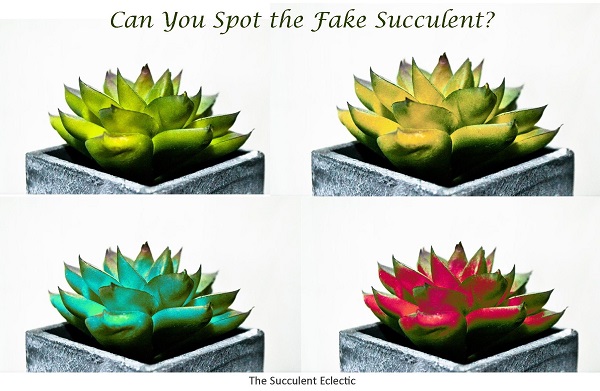
You can indulge your love of succulents and avoid succulent scams by working with reputable growers and vendors. My favorite succulent sellers are Mountain Crest Gardens, Leaf & Clay and The Succulent Source. Their quality is consistently exceptional, and their business model relies on their sterling reputations for quality and honesty. You will never be scammed when you do business with one of these companies.
But that doesn’t mean there are no other solid vendors worthy of your trust. On Amazon, Hirt’s Gardens, Shop Succulents and Plants for Pets all have excellent reputations. I have done business with each and been impressed with the quality they deliver. I’m certain there are many other great vendors, too. Look for positive reviews and lots of them. Read them carefully. When you’re dealing with live plants being shipped across country occasional problems are bound to occur. But a good company will make them right. Does the listing include the succulent’s scientific name? Is the image believable? Is accurate care information provided? Does the vendor answer questions? These are clues to look for when you’re evaluating a new vendor.
If you are eager to try a new vendor or to buy an exciting succulent, ask others to weigh in. My new Facebook group for succulent-lovers will give you feedback on vendors or images. Post a picture of the succulent you want, and ask others if they think it is real. Or contact me! You can send me a link or images by email, or contact me through Facebook at The Succulent Eclectic. I’ll be happy to check over a listing and let you know what I think.
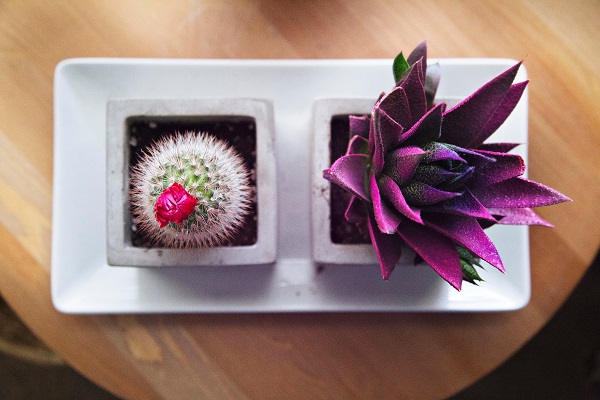
Don’t let succulent scams turn you off your love for these incredible plants! You don’t need painted succulents or fake flowers on cactus to know the genuine plants are beautiful. Once you know these gimmicks and scams exist, you’ll be better able to navigate the world of amazing succulents. And whenever you’re in doubt — reach out and ask! I am always happy to help, as will any other real gardener! 🙂
Comments or questions? Bring ’em on!
P.S. Please subscribe to The Succulent Eclectic and I’ll send you my FREE e-course, 7 Steps to Succulent Success! Thanks so much!
P.P.S. Why not join my Facebook Group for succulent lovers? We talk about succulent care, propagation, succulent identification, and design. It’s a warm and welcoming group that would love to meet you!
